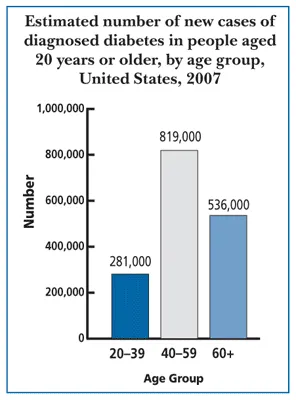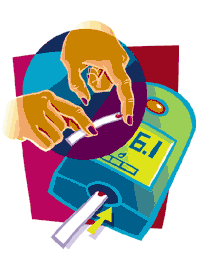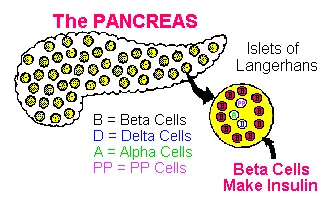Diabetes StimNZ$349.95Approx USD$201.81
Diabetes has become so prevalent that some concerned
health care providers and officials have labeled it, along
with
obesity, as one of the "plagues" of the 21st
century. According to the American Diabetes Association
(ADA), the
number of Americans with diabetes tripled between 1960
and 1990, then doubled again between 1990 and 2000.
U.S. newspapers continuously report the increase in the number of individuals among all age groups who suffer from diabetes.
Despite the major medical advances in rapid and easy monitoring of blood sugar and treatment with drugs, diabetes remains a serious problem. Blood sugar regulation that can be attained by standard methods, particularly when patients are not fully compliant with all medical recommendations, is often not adequate to avoid common secondary effects of diabetes, including cardiovascular diseases, degenerative eye conditions, limb numbness and pain, skin ulceration, and kidney failure. Thus, investigating other avenues for aiding the treatment of diabetes and its secondary consequences is an important undertaking.
Diabetes is a major health problem worldwide, but particularly in America. It is estimated that about 2.1% of the world's population has diabetes, but the disease is out of control in America. In the U.S., current estimates are that over 6% of the adult population has the disease, 99% of them with the type 2 diabetes mellitus (late onset or non-insulin-dependent: NIDDM). Type 2 diabetes usually appears around the age of 50 or later, though it can occur during teen years in some cases of obesity. The incidence rate becomes quite high among elderly Americans (20% for those over the age of 65) and in groups with genetic or other predispositions including blacks (14%), Hispanics (15%), and Native Americans (19%). Furthermore, the overall incidence of diabetes is growing, apparently because of increased rates of obesity. What are common consequences of diabetes?
Diabetes is due to either the pancreas not producing enough insulin, or the cells of the body not responding properly to the insulin produced.[11] There are three main types of diabetes mellitus:[2] Type 1 DM results from the pancreas' failure to produce enough insulin due to loss of beta cells.[2] This form was previously referred to as "insulin-dependent diabetes mellitus" (IDDM) or "juvenile diabetes".[2] The cause is unknown.[2]
According to wikipedia Diabetes mellitus (DM), commonly referred to as diabetes, is a group of metabolic disorders in which there are high blood sugar levels over a prolonged period.[10] Symptoms of high blood sugar include frequent urination, increased thirst, and increased hunger.[2] If left untreated, diabetes can cause many complications.[2] Acute complications can include diabetic ketoacidosis, hyperosmolar hyperglycemic state, or death.[3] Serious long-term complications include cardiovascular disease, stroke, chronic kidney disease, foot ulcers, and damage to the eyes.[2] Diabetes is due to either the pancreas not producing enough insulin, or the cells of the body not responding properly to the insulin produced.[11] There are three main types of diabetes mellitus:[2]
Type 1 DM results from the pancreas' failure to produce enough insulin due to loss of beta cells.[2] This form was previously referred to as "insulin-dependent diabetes mellitus" (IDDM) or "juvenile diabetes".[2] The cause is unknown.[2]
Gestational diabetes is the third main form, and occurs when pregnant women without a previous history of diabetes develop high blood sugar levels.[2]
For many years we wondered why so many of our clients Diabetes had improved after using rife frequencies, we had always suspected that diabetes is in many cases, caused by viruses and pothogens, and the findings below show what we had suspected for years, appears to be correct A new study suggests that a common virus may increase children’s risk for developing type 1 diabete
Recently, considerable progress has been made in studies evaluating the possible role of one virus group, called enteroviruses, which have been connected with human type 1 diabetes in a variety of reports. These viruses are common in children, and more than 100 different enterovirus types have been identified in man. A subset of these enteroviruses can cause serious illnesses such as; myocarditis, meningitis, the hand-food- and -mouth disease as well as paralytic disease such as polio. Although the association between type 1 diabetes and enteroviruses has been observed in various studies, until now it was not known which enterovirus types are most responsible for this effect.
Now, for the first time, a group of collaborating investigators have published results from two studies in the leading scientific diabetes journal Diabetes identifying the enterovirus types which are associated with type 1 diabetes. One study is based on children taking part in the Finnish Type 1 Diabetes Prediction and Prevention (DIPP) study, which is a birth cohort study observing children at genetic risk for type 1 diabetes from birth up to clinical diabetes or 15 years of age. The other study (VirDiab) included children with newly diagnosed diabetes from five European countries. The results from these studies clearly show that members of the group B coxsackieviruses are associated with the risk of type 1 diabetes while the 35 other enterovirus types tested did not show such a connection. These findings are in line with other recent reports suggesting that group B coxsackieviruses can spread to the pancreas and damage the insulin-producing cells. Source In total, 24 case-control studies and two study abstracts (not full publications) met the inclusion criteria. These studies included 4,448 participants (1,931 cases with diabetes or pre-diabetes, and 2,517 controls without diabetes). Most studies defined the condition of pre-diabetes as testing positive for at least one autoantibody associated with type 1 diabetes. Most studies were in children, though some included adults up to the age of 53.When they combined the results of 23 studies in a meta-analysis, the researchers found that the odds of having had enterovirus infection were almost 10 times greater in people with diabetes than in controls without diabetes,Combining the results of nine studies showed that the odds of having had an enterovirus infection in people with type 1 diabetes-related autoimmunity against pancreas cells were almost four times those of controls (OR 3.7, 95% CI 2.1 to 6.8).The researchers concluded that there is a significant association between enterovirus infection and type 1 diabetes or diabetes-related autoimmunity.Source According to Researchers at Karolinska Institutet in Sweden and their Finnish colleagues observations have shown, certain virus infections may play a part in the autoimmune attack that leads to type 1 diabetes.
Many viruses have also been shown to affect the development of diabetes in laboratory animals (reviews of viruses in type 1 include Kondrashova and Hyöty, 2014; Principi et al. 2017; Toniolo et al. 2019; van der Werf et al. 2007). Viruses have even been associated with type 1-related autoimmunity in wild animals (Warvsten et al. 2017). Most studies that have evaluated the association between viruses and type 1 have found that it is highly likely that some viruses do play a role in type 1 diabetes development (Principi et al. 2017). Source Toxoplama gondii, the parasite that causes toxoplasmosis, is also linked to type 1 (Nassief Beshay et al. 2018), as well as type 2 and gestational diabetes (Li et al. 2018). Viruses may interact with other factors related to type 1 diabetes as well. For example, an Italian study found that those with type 1 diabetes had higher rates of enterovirus infection, as well as lower levels of vitamin D. Interestingly, of those with diabetes, people who had signs of infection also had lower vitamin D levels.Source Also, enterovirus infection appears also to be associated with higher intestinal permeability (in people with type 2 diabetes) (Pedersen et al. 2018). Genetic background may also be able to influence the risk of diabetes in relation to viruses (Blanter et al. 2019). Source Viruses and Type 2 Diabetes Helicobacter pylori (H. pylori) is one of the most common human infections and has been associated with the development of type 2 diabetes (Hosseininasab Nodoushan and Nabavi, 2019; Mansouri et al. 2020), but not necessarily type 1 (Esmaeili Dooki et al. 2020; Li et al. 2017). (Although among people who already have type 1 or 2 diabetes, H. pylori is associated with higher long-term blood glucose levels (HbA1c) (Chen et al. 2019).) For example, H. pylori infection was associated with and increased risk of diabetes in people with a lower BMI, and peptic disease (ulcers) were also associated with diabetes. It may be that gastric inflammation and damage to the gut microbiota might play a role in these associations (Haj et al. 2017). H. pylori is also associated with increased insulin resistance (Cherkas et al. 2018) and type 2 diabetes (Kato et al. 2019). A large longitudinal study from Taiwan found that H. pylori was associated with an increased risk of developing type 2 diabetes and metabolic syndrome in men but not women (Chen et al. 2019). Note also that people with higher levels of lead in their blood may have a higher risk of H. pylori infection (Park et al. 2019).
Q. How do Rife machines frequencies work? A. There are many different theories behind Rife machines. Bacteria and virus break a part at certain frequencies. Electrical stimulation makes the immune system stronger. The body becomes ill from abnormal electrical patterns. Rife machines correct the electrical imbalance in the body. It could be possible that cell regeneration is produced by certain frequencies. Royal Rife focused on refining his method of destroying viruses. He used the same principle to kill them, which made them visible - resonance. By increasing the intensity of a frequency with his Rife machine which resonated naturally with these microbes, Royal Rife Frequency kills Paramecium Royal Rife increased their natural oscillations until they distorted and disintegrated from structural stresses. Rife called this frequency the mortal oscillatory rate, or MOR. Importantly noted is the fact that mortal oscillator did not harm the surrounding tissues.
To better understand this principle, think about how a wine glass can be shattered by an intense musical note, while other breakables near the glass are not affected. Every material has a natural frequency at which it vibrates, called a resonant frequency. If you put energy into the substance at its resonant frequency, you will force it to vibrate or resonate. Some singers can sing a note equal to the natural resonant frequency of the wine glass and cause it to shatter. Since everything else has a different resonant frequency, nothing but the glass is destroyed. (Resonance has even caused bridges to collapse. Marching troops of soldiers will often break cadence when crossing a bridge to prevent a resonance collapse.) Introducing the latst Diabetes Stim, 108 frequencies plus 2500hz Carrier wave
108 of the most widely used and accepted Royal Rife Diabetes frequencies / harmonics ,These virus smashing ,Frequencies run one after the other,,program loops continuosly, as lomg as its turned on.
Two electrodes cover the two arteries on the inside of the wrist
Journal References: O. H. Laitinen, H. Honkanen, O. Pakkanen, S. Oikarinen,
M. M. Hankaniemi, H. Huhtala, T. Ruokoranta, V. Lecouturier,
P. Andre, R. Harju, S. M. Virtanen, J. Lehtonen, J. W. Almond,
T. Simell, O. Simell, J. Ilonen, R. Veijola, M. Knip, H.
Hyoty. Coxsackievirus B1 Is Associated With Induction of ß-Cell
Autoimmunity That Portends Type 1 Diabetes. Diabetes, 2013;
DOI: 10.2337/db13-0619 |
Your IP Address is: 18.116.12.252
Copyright © 2025 Altered States. Powered by Zen Cart
















